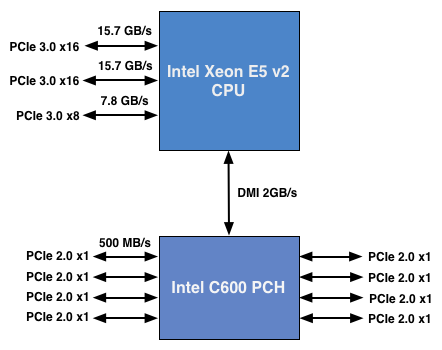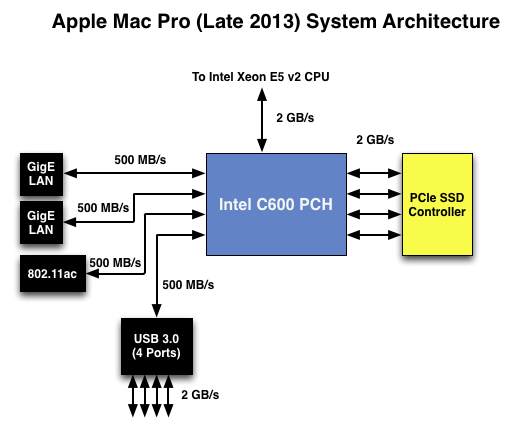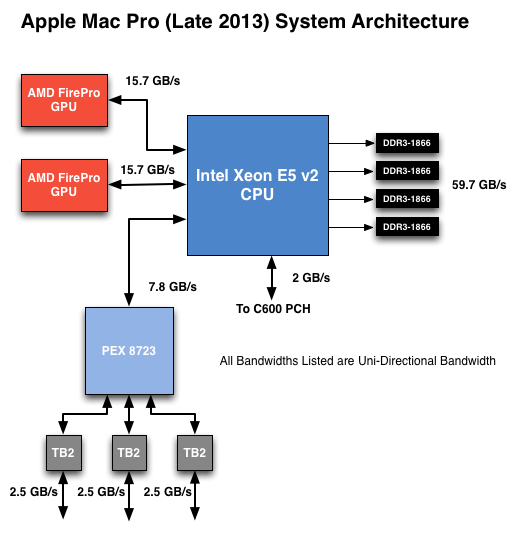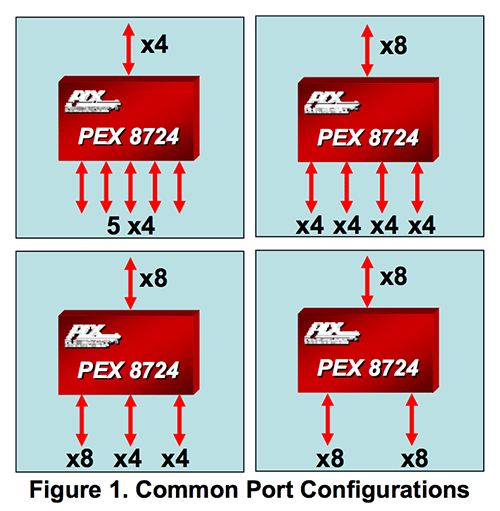The Mac Pro Review (Late 2013)
by Anand Lal Shimpi on December 31, 2013 3:18 PM ESTThe PCIe Layout
Ask anyone at Apple why they need Ivy Bridge EP vs. a conventional desktop Haswell for the Mac Pro and you’ll get two responses: core count and PCIe lanes. The first one is obvious. Haswell tops out at 4 cores today. Even though each of those cores is faster than what you get with an Ivy Bridge EP, for applications that can spawn more than 4 CPU intensive threads you’re better off taking the IPC/single threaded hit and going with an older architecture that supports more cores. The second point is a connectivity argument.
Here’s what a conventional desktop Haswell platform looks like in terms of PCIe lanes:

You’ve got a total of 16 PCIe 3.0 lanes that branch off the CPU, and then (at most) another 8 PCIe 2.0 lanes hanging off of the Platform Controller Hub (PCH). In a dual-GPU configuration those 16 PCIe 3.0 lanes are typically divided into an 8 + 8 configuration. The 8 remaining lanes are typically more than enough for networking and extra storage controllers.
Ivy Bridge E/EP on the other hand doubles the total number of PCIe lanes compared to Intel’s standard desktop platform:

Here the CPU has a total of 40 PCIe 3.0 lanes. That’s enough for each GPU in a dual-GPU setup to get a full 16 lanes, and to have another 8 left over for high-bandwidth use. The PCH also has another 8 PCIe 2.0 lanes, just like in the conventional desktop case.
I wanted to figure out how these PCIe lanes were used by the Mac Pro, so I set out to map everything out as best as I could without taking apart the system (alas, Apple tends to frown upon that sort of behavior when it comes to review samples). Here’s what I was able to come up with. Let’s start off of the PCH:

Here each Gigabit Ethernet port gets a dedicated PCIe 2.0 x1 lane, the same goes for the 802.11ac controller. All Mac Pros ship with a PCIe x4 SSD, and those four lanes also come off the PCH. That leaves a single PCIe lane unaccounted for in the Mac Pro. Here we really get to see how much of a mess Intel’s workstation chipset lineup is: the C600/X79 PCH doesn’t natively support USB 3.0. That’s right, it’s nearly 2014 and Intel is shipping a flagship platform without USB 3.0 support. The 8th PCIe lane off of the PCH is used by a Fresco Logic USB 3.0 controller. I believe it’s the FL1100, which is a PCIe 2.0 to 4-port USB 3.0 controller. A single PCIe 2.0 lane offers a maximum of 500MB/s of bandwidth in either direction (1GB/s aggregate), which is enough for the real world max transfer rates over USB 3.0. Do keep this limitation in mind if you’re thinking about populating all four USB 3.0 ports with high-speed storage with the intent of building a low-cost Thunderbolt alternative. You’ll be bound by the performance of a single PCIe 2.0 lane.
That takes care of the PCH, now let’s see what happens off of the CPU:

Of the 40 PCIe 3.0 lanes, 32 are already occupied by the two AMD FirePro GPUs. Having a full x16 interface to the GPUs isn’t really necessary for gaming performance, but if you want to treat each GPU as a first class citizen then this is the way to go. That leaves us with 8 PCIe 3.0 lanes left.
The Mac Pro has a total of six Thunderbolt 2 ports, each pair is driven by a single Thunderbolt 2 controller. Each Thunderbolt 2 controller accepts four PCIe 2.0 lanes as an input and delivers that bandwidth to any Thunderbolt devices downstream. If you do the math you’ll see we have a bit of a problem: 3 TB2 controllers x 4 PCIe 2.0 lanes per controller = 12 PCIe 2.0 lanes, but we only have 8 lanes left to allocate in the system.
I assumed there had to be a PCIe switch sharing the 8 PCIe input lanes among the Thunderbolt 2 controllers, but I needed proof. Our Senior GPU Editor, Ryan Smith, did some digging into the Mac Pro’s enumerated PCIe devices and discovered a very familiar vendor id: 10B5, the id used by PLX Technology. PLX is a well known PCIe bridge/switch manufacturer. The part used in the Mac Pro (PEX 8723) is of course not listed on PLX’s website, but it’s pretty close to another one that PLX is presently shipping: the PEX 8724. The 8724 is a 24-lane PCIe 3.0 switch. It can take 4 or 8 PCIe 3.0 lanes as an input and share that bandwidth among up to 16 (20 in the case of a x4 input) downstream PCIe lanes. Normally that would create a bandwidth bottleneck but remember that Thunderbolt 2 is still based on PCIe 2.0. The switch provides roughly 15GB/s of bandwidth to the CPU and 3 x 5GB/s of bandwidth to the Thunderbolt 2 controllers.

Literally any of the 6 Thunderbolt 2 ports on the back of the Mac Pro will give you access to the 8 remaining PCIe 3.0 lanes living off of the CPU. It’s pretty impressive when you think about it, external access to a high-speed interface located on the CPU die itself.
The part I haven’t quite figured out yet is how Apple handles DisplayPort functionality. All six Thunderbolt 2 ports are capable of outputting to a display, which means that there’s either a path from the FirePro to each Thunderbolt 2 controller or the PEX 8723 switch also handles DisplayPort switching. It doesn’t really matter from an end user perspective as you can plug a monitor into any port and have it work, it’s more of me wanting to know how it all works.










267 Comments
View All Comments
OreoCookie - Thursday, January 2, 2014 - link
You link to a $2000 workstation without graphics cards and just 8 GB RAM. How does that invalidate Anand's claim?DukeN - Thursday, January 2, 2014 - link
I paid $144 for the extra RAM and re-used my old workstation cards.Hardly double the price.
zsquared - Thursday, January 2, 2014 - link
So you are not counting the original cost of the workstation cards but you think you proved you point.And you're telling Anand "Shame"?
Ppietra - Friday, January 3, 2014 - link
memory: 1600 MHz vs 1866 MHzSSD: SATA600 vs PCIe
no thunderbolt
no graphics
clearly the same specs
DukeN - Friday, January 3, 2014 - link
Even with a decent card it's something like $1500 less.This is a fact that isn't acknowledged by Anand, of course because not cozying up to Apple is potentially bad for business.Oh well I'll never be able to convince the Apple fanboys writing or reading here.
Ppietra - Friday, January 3, 2014 - link
the comparison wasn’t about what you can get with the same processor, but how much does it cost to have the same specs, and your comparison doesn’t do that, and you certainly don’t get a machine with the same performance since memory and storage are slower.How do you get it for $1500 less when your machine base price is 1000$ less. If you add 2 decent graphic cards (with comparable performance) and the extra memory to match you quickly get at the Mac Pro price and still you would probably get worse performance!
Liquidmark - Friday, January 3, 2014 - link
Where's your graphics card?8GB of ram?
SATA SSD?
Here's what I got so far from lenovo's site...
Intel Xeon E5-1620 v2 Processor (10MB Cache, 3.70GHz)
Windows 8 Pro 64 Downgrade Windows 7 Professional 64 English
Tower 5x6 Mechanical Shell with low inrush current power supply
Windows 8 Pro 64 RDVD English
16GB ECC 2Rx4 PC3 1600MHz RDIMM
NVIDIA® Quadro K2000D (2GB Dual link DVI+DVI, Mini DP) - (For Windows 7 ME8.0)
NVIDIA® Quadro K2000D (2GB Dual link DVI+DVI, Mini DP) - (For Windows 7 ME8.0)
DVI to VGA Dongle
Integrated Audio
Intel SATA HDD support (1-3 HDDs)
Internal RAID - Not Enabled
2.5" 256GB SATA SolidState Drive
29-in-1 Media Card Reader - (For Windows 7 ME8.0)
DVD Burner/CD-RW Rambo Drive (SATA) - Win7 ME8.0
Integrated Ethernet
USB Preferred Pro FullSize Win8 US Euro English 103P
Lenovo USB Optical Wheel Mouse
LineCord - US
Publication - English
$4,128.00
Mac Pro with 16 gb instead of 12 for ram...
$3,099.00
Come on man...
Liquidmark - Friday, January 3, 2014 - link
Oop, I forgot the Applecare!Ok, Mac Pro= $3,348.00
Lenovo Lenovo S30= $4,128.00
RollingCamel - Thursday, January 2, 2014 - link
No engineering software performance review?wheelhot - Saturday, January 4, 2014 - link
I wonder why as well, I don't see anything wrong to do some windows engineering software tests